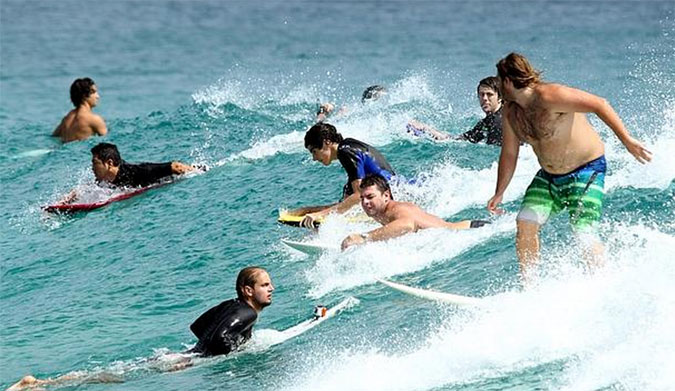“Next time you head for the water, give me a call, I’d love to give it a go.” These are the words that are never met with anything more than a forced smile and a “Yeah sure, that’d be great.” There won’t be a call; adding to the fodder in the water isn’t an option. Plus, no one wants to be responsible for the enthusiastic novice, who is dangerously wielding a 9-foot sponge board and seeing how much seawater can be swallowed before insanity sets in. Perhaps it’s the inevitable sodium overdose that’s responsible for the perma-grin now adorning the newbie’s face. But if you do find yourself in this awful situation, it’s your responsibility to ensure that those determined folks give it a go one time and one time only. Follow these surefire ways to make their foray into wave riding a brief and forgettable experience.
1. Find the shortest, thinnest, and least buoyant board you can find.
For learning, bigger is better and stability is key. You need something to cope with the shaky Bambi legs. Surf schools opt for the ginormous foam type affair, but not us. We’re going to equip our newbie with the shortest, thinnest, and least buoyant board we can lay our hands on. Never mind standing up, just laying on this board is going to be a challenge for our champ. If by any miraculous occurrence they manage to maneuver themselves into a wave catching opportunity, chances are they won’t have the paddling power to propel themselves into the wave. They’ll pearl the board. Job well done.
2. The bigger and more hollow, the better.
No mellow, neatly organized peaks with softly jacking up shoulders to paddle onto here. Something suitably hollow and ferociously closing out is perfect. No long lulls to ensure a nice, easy paddle out to the lineup. It should be relentless. Let our surfer realize just how fit the rest of us are. Without any effective duck diving technique, getting out the back is going to be tricky. If they do make it out, there will be little or no strength left for catching waves. The odd cleanup set is a bonus, meaning the whole process can start over again. Chances are they won’t make it out the second time anyway.
3. Big, baggy, ill-fitting neoprene with leaking seams is a plus.
The colder the water, the better. But make sure any neoprene items are the most ill-fitting, sieve-like versions of wetsuits as possible. Leaking seams are a must, dodgy zips are preferable, and either several sizes too big in order to create a water balloon effect, or one several sizes too small to restrict movement and blood flow will do. Boots, gloves, skull caps, super stretch neoprene… obviously not. Being cold in the ocean is miserable. Let’s harness this misery.
4. The reef is your friend. It’s everyone’s.
Be careful with this one. I’m not suggesting sending somebody out to Uluwatu on low tide, simultaneously introducing him or her to wave riding and local hospital. However, what’s a few reef cuts between friends? The perfect scenario here is a nice deep reef with enough water to ensure there isn’t going to be any permanent damage, but enough of the local geology to make wading out uncomfortable, and to rule out taking any ill-deserved mid-session breaks by standing in the shallow water. Soft sand is for lying on.
5. Remind them dying is a real-life possibility.
If only we had documentation of a surfer going about his everyday business, and suddenly, through no fault of his own, came under attack by a ferocious, teeth-baring sea creature. Well, now is the time to add some more hits to that now-famous heat in the world of surfing. Sell the footage as essential safety advice, emphasize the fact that it really could happen to anyone at anytime. Maybe throw in a few monster Teahupo’o wipeouts for good measure. Run through staying calm during a hold down and practice holding your breath. Play this one effectively and your protégé may not even get as far as the water’s edge.
There you have it, folks. Five simple ways to ensure the status quo of the surfing population. Any I’ve missed?


